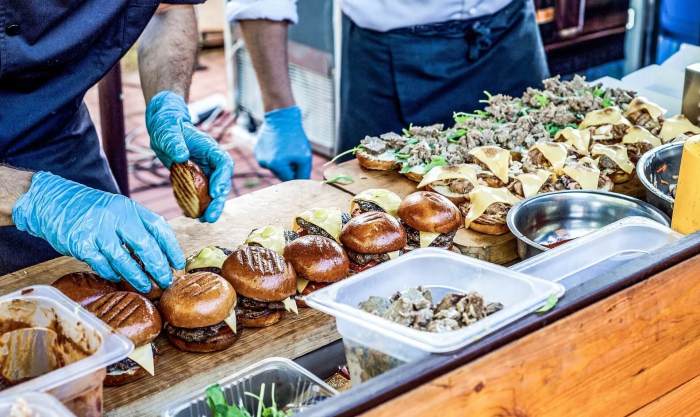Snacking is the new diet, challenging the traditional notions of meal frequency and portion sizes. This approach emphasizes mindful eating and strategic snacking throughout the day, rather than large, infrequent meals. It’s about understanding how to use snacks to manage hunger, cravings, and overall well-being. The article explores the core tenets, benefits, drawbacks, and practical considerations of this evolving dietary philosophy.
This guide will delve into the different types of snacking strategies, comparing them to traditional dieting methods. We’ll also explore the relationship between snacking and emotional eating, providing strategies for managing emotional eating while adhering to a snacking-based diet. Furthermore, practical considerations and planning, along with adapting snacking strategies for diverse dietary needs, will be thoroughly discussed. Finally, we’ll examine the sustainability aspect of different snacking choices.
Defining Snacking as a Diet Approach
The “snacking is the new diet” concept challenges traditional notions of meal frequency and portion control. It promotes a flexible approach to eating, emphasizing mindful choices and balanced nutrition across the day, rather than rigid meal plans. This approach recognizes that hunger and cravings can fluctuate throughout the day, and suggests that strategically planned snacks can help manage these fluctuations while promoting overall well-being.This philosophy is not about simply eating small portions throughout the day.
It’s about mindful snacking that considers the body’s nutritional needs and energy levels. The focus is on choosing nutrient-dense foods, controlling portion sizes, and avoiding processed snacks. It’s a paradigm shift from the often restrictive and unsustainable nature of many traditional diets.
Core Tenets of the Snacking Diet Approach
This approach emphasizes a mindful, balanced approach to nutrition, acknowledging that hunger and energy levels fluctuate throughout the day. Instead of large, infrequent meals, this strategy suggests several smaller, balanced meals and snacks. This often leads to better blood sugar regulation and sustained energy levels.
- Balanced Macronutrients: This approach prioritizes a balance of proteins, carbohydrates, and healthy fats in each snack. This ensures sustained energy levels and satiety, helping to prevent overeating at subsequent meals. For example, a snack combining protein (Greek yogurt), complex carbohydrates (berries), and healthy fats (nuts) provides sustained energy and helps maintain blood sugar balance.
- Mindful Portion Control: Consciously choosing appropriate portion sizes is key. Understanding serving sizes and listening to body cues are vital components of this approach. A small handful of almonds, a piece of fruit, or a small serving of vegetables can be satisfying snacks without leading to overconsumption.
- Nutrient Density: Choosing nutrient-dense snacks is essential. Fruits, vegetables, lean proteins, and healthy fats are preferred over processed foods or sugary drinks. This emphasis on whole foods provides essential vitamins, minerals, and fiber, contributing to overall health. For instance, a handful of spinach with hummus and a piece of whole-wheat toast provide substantial nutrients without excessive calories.
Different Snacking Strategies
This approach involves a range of strategies that cater to individual needs and preferences. These methods vary based on specific goals, such as weight management, increased energy, or improved digestion.
- Time-Based Snacking: Consuming snacks at regular intervals throughout the day, often every 2-3 hours. This approach aims to maintain consistent energy levels and prevent extreme hunger pangs. This method also helps regulate blood sugar. For instance, consuming a fruit salad at 10 AM can help curb midday hunger.
- Hunger-Based Snacking: Eating when hunger cues appear. This approach allows for flexibility, but mindful portion control is crucial to prevent overeating. Listening to the body’s hunger cues and providing appropriate snacks is a key element of this strategy. For example, a small bowl of soup can be a satisfying snack when hunger strikes.
- Meal Replacement Snacking: Utilizing certain snacks as substitutes for full meals. This approach is often used for weight management and requires careful consideration of nutritional content and caloric intake. For instance, a protein shake and fruit can be a viable replacement for a full breakfast.
Contrast with Traditional Diets
The snacking-as-diet approach differs significantly from traditional dieting methods in its emphasis on flexibility, balance, and mindful eating. Traditional diets often involve restrictive meal plans, leading to potential nutritional deficiencies and difficulty maintaining long-term adherence.
| Feature | Traditional Diets | Snacking-as-Diet Approach |
|---|---|---|
| Meal Frequency | Typically 3 meals per day | Multiple small meals and snacks throughout the day |
| Portion Sizes | Often prescribed fixed portions | Mindful portion control based on individual needs |
| Food Choices | Frequently restrictive, focusing on specific foods | Balanced diet encompassing a variety of nutrient-dense foods |
Benefits and Drawbacks of Snacking as a Diet

Snacking, often perceived as a diet villain, can actually be a powerful tool for weight management and overall well-being when approached strategically. However, the key lies in understanding the potential pitfalls and implementing mindful practices to harness its benefits. A well-planned snacking approach can offer a balanced alternative to restrictive diets, potentially improving blood sugar control and preventing energy crashes.Snacking, when properly integrated into a dietary plan, can offer a multitude of advantages.
This approach allows for the intake of essential nutrients and can improve blood sugar control. Furthermore, regular, mindful snacking can potentially contribute to a more stable energy level throughout the day, reducing cravings for unhealthy options and potentially preventing overeating at mealtimes.
Potential Benefits of Regular Snacking
Regular snacking, when strategically planned, can be a boon for managing energy levels and promoting satiety. By providing a consistent supply of nutrients, it can help regulate blood sugar levels, minimizing the risk of energy crashes and subsequent cravings. This consistent nutrient intake can also help in better nutrient absorption, which is crucial for overall health.
- Improved Blood Sugar Control: Regular snacking, when well-planned, can help to stabilize blood sugar levels by preventing large fluctuations. This can be particularly beneficial for individuals with pre-existing conditions or those aiming for improved metabolic health.
- Enhanced Energy Levels: Strategic snacking can help maintain stable energy levels throughout the day, preventing the energy slumps that often lead to unhealthy choices. Nutritious snacks provide sustained energy release, promoting focus and productivity.
- Reduced Cravings: Regular, healthy snacking can help to mitigate cravings for less healthy foods. By keeping hunger at bay, the desire for processed snacks or sugary treats is often diminished.
- Improved Nutrient Intake: Strategically chosen snacks can supplement dietary needs and ensure the body receives essential nutrients that might be lacking in the main meals.
Potential Drawbacks of Snacking as a Primary Dietary Strategy
While snacking can be beneficial, it can also present significant drawbacks if not implemented correctly. Overindulgence, lack of portion control, and poor snack choices can quickly lead to negative health consequences.
- Weight Gain: The primary concern with snacking as a primary dietary approach is the potential for weight gain. If portion sizes are not monitored carefully and if unhealthy snack options are chosen, calorie intake can quickly surpass daily needs, leading to unwanted weight gain.
- Nutrient Imbalances: If snacking is not well-planned, it can lead to imbalances in nutrient intake. Overemphasis on certain snacks might result in a lack of crucial vitamins and minerals from other food groups.
- Digestive Issues: Unhealthy snacks, especially those high in processed ingredients, can contribute to digestive discomfort, bloating, and other related issues. Furthermore, eating too frequently can overload the digestive system.
- Increased Calorie Intake: Snacking, if not monitored, can easily lead to an increase in daily calorie intake, potentially exceeding caloric expenditure and contributing to weight gain. Unhealthy snacks contribute significantly to this issue.
Comparison with Other Dietary Philosophies
Snacking as a diet differs significantly from other popular approaches. For example, the Mediterranean diet emphasizes whole foods, balanced meals, and healthy fats, while the ketogenic diet focuses on very low carbohydrate intake. Snacking, in its most effective form, complements these approaches by maintaining energy levels and addressing hunger pangs between meals.
The Role of Portion Control and Mindful Snacking
The key to maximizing the benefits and minimizing the risks of snacking as a dietary approach lies in portion control and mindful snacking. A balanced approach involves selecting healthy snacks in appropriate quantities, paying attention to hunger cues, and avoiding emotional eating. A balanced approach can help mitigate the potential drawbacks.
Pros and Cons of Snacking as a Diet, Snacking is the new diet
| Category | Pros | Cons |
|---|---|---|
| Physical Health | Improved blood sugar control, enhanced energy levels, reduced cravings | Weight gain, nutrient imbalances, digestive issues, increased calorie intake |
| Mental Well-being | Stable mood, reduced stress, increased focus | Potential for emotional eating, anxiety related to portion control |
| Lifestyle Impacts | Convenience, flexibility, reduced overeating | Potential for impulsive snacking, difficulty with meal planning, increased time spent snacking |
Food Choices and Snacking Strategies: Snacking Is The New Diet
Snacking, when strategically planned, can be a valuable part of a healthy diet. It’s about making mindful choices and understanding how different foods impact your body. This section delves into the specifics of creating healthy snacking habits, from choosing the right foods to controlling portions and managing cravings.The key to successful snacking is understanding that it’s not about mindless consumption, but about thoughtful nourishment.
Snacking is officially the new diet, it seems. Packing the right mix of energy-boosting snacks is crucial, especially when you’re on the go, like a true adventurer. Think about the challenges faced by backpackers – those who understand the art of efficient food storage and the importance of the perfect trail mix. You can learn more about that from this article on 7 things only backpackers would understand: 7 things only backpackers would understand.
It’s all about mindful snacking, choosing nutrient-dense options, and understanding the value of strategic fuel stops, whether you’re hiking a mountain or just hitting the gym.
By selecting nutritious snacks and implementing portion control strategies, you can leverage snacking to fuel your body and maintain a healthy lifestyle.
Healthy Snack Options
A wide variety of healthy snacks can fit into a snack-based diet. These snacks should be nutrient-dense, providing sustained energy and essential vitamins and minerals. Prioritize whole foods over processed alternatives whenever possible.
- Fruits and vegetables, such as apples, bananas, berries, carrots, celery, and bell peppers, are excellent choices. They are packed with vitamins, minerals, and fiber, which promote satiety and aid digestion. Fruits and vegetables are naturally low in calories and high in volume, making them ideal for keeping hunger at bay between meals.
- Whole-grain crackers, rice cakes, or popcorn are good carbohydrate sources. Choose varieties without added sugar or unhealthy fats. These provide sustained energy and can be paired with lean protein or healthy fats for a more balanced snack.
- Hard-boiled eggs, Greek yogurt, or cottage cheese are excellent sources of protein. Protein-rich snacks help you feel full and satisfied, preventing overeating later in the day. They also support muscle repair and growth.
- Nuts and seeds, such as almonds, walnuts, and pumpkin seeds, are good sources of healthy fats, protein, and fiber. They provide sustained energy and essential nutrients. Portion control is key, as nuts and seeds can be calorie-dense.
Incorporating Macronutrients into Snacking Plans
A balanced snack should include a variety of macronutrients: carbohydrates, proteins, and healthy fats. This ensures sustained energy levels and a balanced nutritional intake.
- Whole grains, like whole-wheat bread or brown rice, provide complex carbohydrates for sustained energy. Pairing these with protein and healthy fats can create a well-rounded snack that keeps you full for longer.
- Fruits, vegetables, and legumes are rich in vitamins, minerals, and fiber. They offer natural sweetness and promote satiety, making them excellent choices for snacking. Choose colorful fruits and vegetables to maximize your intake of diverse nutrients.
- Lean proteins, such as poultry, fish, beans, and lentils, provide essential amino acids for muscle repair and growth. These snacks can be combined with healthy fats and carbohydrates for a more complete meal replacement.
- Healthy fats, found in avocados, nuts, seeds, and olive oil, contribute to hormone production and nutrient absorption. They also enhance flavor and promote satiety, making them valuable components of a snack plan.
Portion Control and Cravings Management
Portion control is crucial for a successful snacking diet. Understanding appropriate portion sizes prevents overconsumption and helps manage cravings.
- Using measuring cups and spoons can help in accurately portioning snacks. This prevents overestimating or underestimating the amount consumed.
- Paying attention to hunger and fullness cues is essential. Eat until you are satisfied, not stuffed. This helps you avoid overeating and manage cravings effectively.
- Avoid mindless snacking. Engage in activities that distract you from eating, like reading or talking to someone, to help you eat more consciously.
- Prepare healthy snacks in advance to have readily available options. This helps in making healthy choices when hunger strikes.
Sample Snack Ideas
| Macronutrient Profile | Snack Idea | Portion Size |
|---|---|---|
| Protein | Greek yogurt with berries and a sprinkle of granola | 1 cup yogurt, 1/2 cup berries, 1/4 cup granola |
| Carbohydrates | Whole-wheat crackers with avocado slices and a sprinkle of salt | 4 crackers, 1/4 avocado |
| Fat | Handful of almonds and a few slices of cucumber | 1/4 cup almonds, 2 slices cucumber |
| Balanced | Apple slices with almond butter | 1 medium apple, 2 tablespoons almond butter |
Relationship Between Snacking and Emotional Eating
Snacking, when approached thoughtfully, can be a healthy component of a balanced lifestyle. However, the line between mindful snacking and emotional eating can be blurry. Understanding the connection between our emotional states and snacking choices is crucial for maintaining a sustainable and fulfilling snacking-based diet. This understanding allows us to identify triggers, develop coping mechanisms, and cultivate healthier relationships with food.Emotional eating, often driven by feelings rather than physical hunger, can significantly impact snacking habits.
When dealing with stress, sadness, or boredom, reaching for snacks becomes a common coping mechanism. This can lead to overeating and potentially derail the overall goals of a snacking-based diet.
Emotional Triggers and Snacking Patterns
Emotional states frequently influence our food choices. A common observation is the tendency to turn to comfort foods, often high in sugar or fat, when experiencing negative emotions. Recognizing these patterns allows us to develop more effective strategies for managing cravings. Understanding the correlation between specific emotions and corresponding snacking triggers is essential for creating a personalized plan.
Strategies for Managing Emotional Eating
Developing strategies for managing emotional eating is paramount to a successful snacking-based diet. Recognizing the connection between emotions and cravings is a vital first step. Implementing mindfulness techniques can help to identify and regulate these emotional responses.
Mindful Eating Techniques
Mindful eating techniques offer valuable tools for enhancing self-awareness. These techniques encourage paying attention to the sensations of hunger and fullness. By focusing on the physical experience of eating, we can develop a clearer understanding of our body’s signals.
- Paying attention to hunger and fullness cues: Instead of automatically reaching for a snack when a feeling arises, take a moment to notice the physical sensations in your stomach. Is it a true rumbling feeling, or is it a mental desire? Identifying the difference is crucial for distinguishing physical hunger from emotional cravings. Practicing mindful eating, where you savor each bite and pay attention to the taste, texture, and smell of the food, helps in this process.
Snacking is the new diet, and it’s all about mindful choices, not deprivation. It’s about balancing healthy options with your cravings. To keep the spark in your relationship, though, you need more than just snacks. Try these 10 tricks to keep the spark alive 10 tricks keep the spark your relationship. Ultimately, mindful snacking is about listening to your body and making healthy choices, just like nurturing a strong relationship takes effort and awareness.
It’s about balance, not perfection.
- Identifying emotional triggers: Maintaining a food journal can be extremely helpful. Note down what you ate, when you ate it, and how you felt at the time. This allows for identifying patterns between specific emotions and food cravings. This is a vital step to create strategies for managing cravings.
- Developing healthy coping mechanisms: Explore alternative activities to address emotional distress. Engaging in hobbies, spending time in nature, exercising, or practicing relaxation techniques can provide healthier outlets for managing emotions. Finding healthier ways to deal with stress can reduce the reliance on food as a coping mechanism.
Distinguishing Physical Hunger from Emotional Cravings
It’s crucial to differentiate between physical hunger and emotional cravings. Physical hunger is a physiological need, characterized by a specific sensation in the stomach and a desire for nutritious food. Emotional cravings, on the other hand, are driven by feelings and can manifest as a desire for specific foods, often unrelated to actual hunger.
Table: Emotional States and Snacking Triggers
| Emotional State | Snacking Trigger | Alternative Coping Mechanism |
|---|---|---|
| Stress | Salty snacks, sugary treats | Deep breathing exercises, listening to calming music, engaging in a hobby |
| Boredom | Chips, cookies, candy | Engage in a productive activity, call a friend, try a new recipe |
| Sadness | Comfort foods, ice cream | Spend time with loved ones, watch a funny movie, engage in a creative activity |
| Anxiety | Grabbing anything readily available | Engage in physical activity, practice mindfulness, talk to a friend or family member |
Practical Considerations and Planning

Snacking as a diet approach requires careful planning and preparation to ensure success and long-term adherence. Simply deciding to eat more snacks doesn’t automatically translate to a healthy or sustainable eating pattern. Effective snacking necessitates a structured approach that aligns with individual needs and goals. This involves more than just grabbing a handful of chips; it’s about mindful choices and proactive planning.A well-planned snacking-based diet fosters a sense of control and awareness, preventing impulsive or unhealthy choices.
It also allows for greater flexibility and adaptability throughout the day, making it more manageable to navigate various situations.
Snacking is definitely the new diet trend, and it’s not just about grabbing a handful of chips. It’s about mindful choices and portion control, just like teaching kids to read requires a structured approach. Learning to pick healthy snacks and portion them correctly, like how to teach kids to read involves a lot of practice and consistency, is a key element of the modern approach to nutrition.
Ultimately, a healthy snacking routine is all about making informed decisions, just like any other important skill.
Importance of Planning and Preparation
Effective planning is crucial for a successful snacking-based diet. Without a plan, it’s easy to fall into unhealthy habits or miss important nutritional needs. Pre-planning meals and snacks ensures a readily available supply of healthy options, making it less likely to resort to less nutritious choices when hunger strikes. Preparation involves more than just purchasing healthy foods; it encompasses portioning, organizing, and even prepping ingredients in advance to streamline the snacking process.
Meal Prep Strategies for Healthy Snacks
Meal prepping for a snack-based diet involves strategically preparing and storing various healthy snack options. This ensures a consistent supply of nutritious choices throughout the week.
- Portioning and Packaging: Portion out snacks into individual containers for easy grabbing. Use clear containers to visually identify the contents and avoid overeating. Consider reusable snack bags or containers for environmental consciousness.
- Batch Cooking: Prepare large batches of healthy snacks, like roasted vegetables, hard-boiled eggs, or overnight oats, and store them in the refrigerator or freezer for quick access. This saves time and ensures a ready supply of healthy options.
- Prep Ahead: Chop vegetables, fruits, and other snack ingredients in advance. This simplifies the process of creating quick and healthy snacks during busy days. Consider pre-portioning nuts, seeds, or dried fruits for added convenience.
Maintaining a Balanced Lifestyle
A snacking-based diet isn’t just about food; it’s about maintaining a holistic approach to well-being. A balanced lifestyle is vital to reaping the full benefits of this approach. This involves incorporating adequate sleep, regular exercise, and stress management techniques.
- Prioritize Sleep: Adequate sleep is essential for maintaining a healthy metabolism and managing hunger hormones. Insufficient sleep can disrupt these hormones, potentially leading to increased cravings and overeating.
- Incorporate Regular Exercise: Physical activity is key to maintaining a healthy weight and overall well-being. Exercise helps regulate appetite and improve energy levels, which can be helpful when following a snacking-based diet.
- Manage Stress Levels: Chronic stress can contribute to emotional eating. Implementing stress-reducing techniques, such as meditation or yoga, can positively impact your approach to snacking.
Exercise and Hydration
Exercise plays a vital role in a snacking-based diet. It helps to regulate appetite, improve energy levels, and supports overall health. Regular hydration is equally important, as it helps to curb hunger and keeps the body functioning optimally.
- Exercise as a Regulator: Physical activity helps to manage hunger and cravings. Exercise burns calories, which can be especially beneficial if you’re incorporating higher-calorie snacks into your diet.
- Hydration for Hunger Management: Often, thirst is mistaken for hunger. Drinking water before and during meals can help to regulate appetite and prevent overeating. Proper hydration is essential for overall health, regardless of the type of diet.
Weekly Meal Plans and Grocery Lists
The following table provides examples of weekly meal plans incorporating snacking strategies, along with corresponding grocery lists. These are templates, and individual needs and preferences should be considered when customizing.
| Day | Breakfast | Lunch | Snacks | Dinner | Grocery List Items |
|---|---|---|---|---|---|
| Monday | Oatmeal with berries and nuts | Salad with grilled chicken | Apple slices with almond butter, carrots with hummus | Baked salmon with roasted vegetables | Oatmeal, berries, nuts, salad greens, chicken breast, almonds, hummus, carrots, apples, salmon, vegetables (broccoli, carrots, etc.) |
| Tuesday | Yogurt with granola and fruit | Leftover salmon and vegetables | Hard-boiled eggs, cucumber slices with cream cheese | Lentil soup | Yogurt, granola, fruit, lentils, eggs, cucumber, cream cheese |
| Wednesday | Whole-wheat toast with avocado | Quinoa salad with chickpeas and veggies | Edamame, trail mix | Chicken stir-fry | Whole-wheat bread, avocado, quinoa, chickpeas, vegetables, edamame, trail mix, chicken breast, stir-fry vegetables |
Snacking and Specific Dietary Needs
Snacking, when strategically planned, can be a powerful tool for managing hunger and maintaining energy levels. However, for individuals with allergies, dietary restrictions, or specific health needs, adapting snacking strategies is crucial for optimal health and well-being. This section delves into customizing snacking plans to accommodate various dietary requirements, ensuring that everyone can enjoy the benefits of snacking.Effective snacking for individuals with specific dietary needs involves careful consideration of food choices, portion control, and mindful eating practices.
Understanding the nuances of different dietary restrictions, like allergies or veganism, is essential to creating a personalized snacking plan that caters to individual needs. This approach allows for a balanced and nutritious diet that meets all dietary requirements.
Adapting Snacking Strategies for Allergies and Dietary Restrictions
Understanding and accommodating dietary restrictions is vital when implementing a snacking-based approach. This requires careful selection of foods that align with the specific needs and preferences of the individual. A detailed understanding of potential allergens and alternative ingredients is key. For instance, gluten-free alternatives should be readily available, and cross-contamination risks should be minimized. Careful reading of food labels is also a crucial part of the process.
Examples of Snack Options for Different Dietary Needs
A wide variety of nutritious and satisfying snacks can be incorporated into a personalized plan, catering to various dietary needs.
- Vegan Snacks: Fruits like apples, bananas, and berries, along with vegetables like carrots and celery with hummus or nut butters, are excellent choices. Edamame, roasted chickpeas, and trail mixes (without honey or dairy) are also great options. Plant-based yogurt alternatives, granola bars made with plant-based milk, and whole-grain crackers can be suitable choices, but careful consideration of ingredients is essential.
- Vegetarian Snacks: Similar to vegan snacks, vegetarians can enjoy fruits, vegetables, and whole grains. However, they can also incorporate cheese, eggs, and yogurt into their snacking plan. Hard-boiled eggs, cheese cubes, and fruit with a dollop of Greek yogurt are examples.
- Food Sensitivities: For individuals with specific food sensitivities, such as lactose intolerance or nut allergies, it’s crucial to carefully examine labels for hidden allergens and opt for alternatives. Dairy-free yogurt alternatives, almond butter (if not allergic to almonds), and rice cakes are good options. Careful planning and preparation are key to ensuring a safe and enjoyable snacking experience.
Portion Control and Mindful Eating in a Personalized Plan
Portion control is essential for effective snacking. Mindful eating, focusing on the taste, texture, and aroma of the snack, can help individuals better appreciate the experience and avoid overeating. Adjusting portion sizes according to individual needs and activity levels is important. For example, a smaller portion of trail mix may suffice for a sedentary individual, while a slightly larger portion may be needed for someone who is highly active.
Balancing Dietary Needs in a Snack-Based Approach
Balancing different dietary needs in a snacking-based approach requires careful planning and organization. A combination of different food groups and a variety of snacks ensures that the body receives essential nutrients. A well-structured snacking plan can support overall health and well-being, while meeting the specific needs of individuals with various dietary requirements. Creating a balanced diet is important for optimal health.
Table of Diverse Snacking Options
| Dietary Restriction/Need | Snack Options |
|---|---|
| Vegan | Fruits, vegetables, nuts, seeds, plant-based yogurt, granola bars (check ingredients), edamame, roasted chickpeas, whole-grain crackers |
| Vegetarian | Fruits, vegetables, nuts, seeds, cheese, eggs, yogurt, whole-grain crackers, hummus |
| Gluten-Free | Fruits, vegetables, rice cakes, gluten-free crackers, gluten-free bread, quinoa snacks |
| Lactose-Free | Fruits, vegetables, nuts, seeds, dairy-free yogurt, lactose-free cheese alternatives, rice milk, almond milk |
| Nut Allergy | Fruits, vegetables, rice cakes, seeds, sunflower seed butter, soy-based nut butter alternatives |
Snacking and Sustainability
Snacking, when thoughtfully approached, can be a perfectly healthy and sustainable part of a balanced lifestyle. However, the environmental impact of our snacking choices is significant. From the farming practices used to the packaging materials employed, each step in the supply chain contributes to our overall ecological footprint. This section will explore the environmental footprint of different snacking options, emphasizing the importance of sustainable choices and minimizing food waste.
Environmental Impact of Snacking Choices
The environmental impact of our snacks extends beyond the production process. Transportation, packaging, and ultimately, disposal, all play a role in the overall ecological footprint of our snacking habits. Different types of snacks have vastly different impacts on the environment. Choosing sustainable and locally sourced options can significantly reduce these impacts.
Importance of Sustainable and Locally Sourced Snacks
Choosing snacks that prioritize sustainability and local sourcing is a powerful step towards reducing our environmental impact. Sustainable practices often involve reducing water usage, minimizing pesticide use, and supporting local farmers. Locally sourced snacks also reduce the distance food travels, decreasing transportation emissions and supporting regional economies. Farmers using sustainable practices often benefit from increased profits, while consumers get healthier, more flavorful, and eco-friendly products.
Reducing Food Waste Associated with Snacking
Food waste is a significant contributor to environmental issues. Proper portion control and careful storage of snacks can significantly reduce waste. Planning snack portions based on individual needs, using reusable containers, and opting for snacks with longer shelf lives can all contribute to minimizing food waste. Investing in durable and reusable snack containers is an effective way to reduce single-use packaging and limit food waste.
Minimizing the Carbon Footprint of a Snacking-Based Diet
Minimizing the carbon footprint of a snacking-based diet requires a multi-faceted approach. Prioritizing plant-based snacks, choosing snacks with minimal processing, and supporting brands with strong environmental certifications can all contribute to a lower carbon footprint. A key part of this involves understanding the lifecycle of your snacks and considering the environmental impact of each step.
Table: Environmental Impact of Snacking Choices
| Snack Category | Origin | Processing | Environmental Impact (Example) |
|---|---|---|---|
| Fruit Snacks | Local Orchard | Minimal Processing | Low, supports local economy, reduces transportation emissions |
| Dried Fruit | Local Orchard | Moderate Processing | Lower than processed chips, still depends on origin and processing |
| Chips | International Farms | High Processing | High, involves extensive transportation, packaging, and often unsustainable farming practices |
| Nuts (almonds, cashews) | International Farms | Moderate Processing | Moderate, depends on farming practices and processing methods |
| Energy Bars | Global Sourcing | High Processing | High, often involves long transportation, high packaging waste, and unsustainable sourcing |
Note: The environmental impact is a generalization. Specific impacts vary based on the particular origin, processing methods, and packaging used.
Concluding Remarks
In conclusion, snacking as a dietary approach offers a flexible and potentially beneficial alternative to traditional dieting. By understanding the nuances of portion control, mindful eating, and healthy food choices, individuals can harness the power of snacking to achieve their health and wellness goals. However, it’s crucial to acknowledge the potential drawbacks and tailor the approach to individual needs and circumstances.
This comprehensive guide provides a framework for understanding and implementing snacking as a viable and sustainable dietary strategy.










